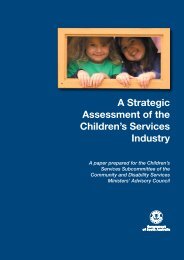Global Study On Child Poverty And Disparities (PDF) - Social Policy ...
Global Study On Child Poverty And Disparities (PDF) - Social Policy ...
Global Study On Child Poverty And Disparities (PDF) - Social Policy ...
You also want an ePaper? Increase the reach of your titles
YUMPU automatically turns print PDFs into web optimized ePapers that Google loves.
deprivation (42 per cent) than households in the<br />
richest 20 per cent of the population (7 per cent).<br />
Thus, this measure tends to show that material<br />
assets are strongly correlated with the likelihood<br />
of deprivation, although the gradient is not as<br />
marked as it is for the broader wealth measure.<br />
Figure 2.11 shows that nearly 60 per cent of<br />
children in households in the lowest wealth quintile<br />
experience at least one severe deprivation,<br />
compared to only 7 per cent in the richest wealth<br />
quintile. This association is not surprising, as the<br />
wealth index is in part defined by the deprivation<br />
measures. For example, household assets are<br />
measured in part by the type of sanitation facilities<br />
the household has, as is sanitation deprivation,<br />
and also by the type of shelter, as is shelter<br />
deprivation.<br />
Figure 2.11: <strong>Child</strong>ren with at least one severe<br />
deprivation by wealth and asset index quintile (%)<br />
70<br />
60<br />
50<br />
40<br />
30<br />
20<br />
10<br />
0<br />
58<br />
42<br />
Wealth<br />
29<br />
24 21<br />
17<br />
Poorest Q2 Q3 Q4 Richest<br />
Source: Estimated from 2007 MICS.<br />
Assets<br />
10 14<br />
7 7<br />
Other factors that are strongly correlated with child<br />
deprivation include the education of the head of<br />
the household and the education of the mother,<br />
as shown in Figure 2.12. <strong>Child</strong>ren in households<br />
where the household head or the mother had no<br />
education were much more likely to be deprived,<br />
and those where adults had secondary education<br />
were much less likely to be deprived.<br />
Figure 2.12: <strong>Child</strong>ren with at least one severe<br />
deprivation by education of head of household<br />
and mother (%)<br />
60<br />
50<br />
40<br />
30<br />
20<br />
10<br />
0<br />
48<br />
27<br />
None Primary Secondary None Primary Secondary<br />
Education of the head of the house Mother’s Education<br />
Source: Estimated from 2007 MICS.<br />
14<br />
Multiple deprivations<br />
An important issue is whether children who<br />
are deprived in one dimension more likely to<br />
be deprived in another, and whether these<br />
deprivations reinforce each other. Table 2.6<br />
shows both the proportion of children in Vanuatu<br />
experiencing specific severe or less severe<br />
deprivations, and the experience of different<br />
combinations of multiple deprivations. As<br />
discussed above, the most common severe<br />
deprivation is information, but the second most<br />
common is health deprivation. At the less severe<br />
level of deprivation, the most common problem<br />
relates to health.<br />
Disregarding information deprivation, while 20 per<br />
cent of children in Vanuatu experience one severe<br />
deprivation, only 4 per cent experience two,<br />
and negligible numbers experience four or more<br />
severe deprivations. Less severe deprivations<br />
are naturally more common – nearly one in three<br />
children in Vanuatu experiences a less severe<br />
deprivation; one in four experiences two less<br />
severe deprivations, and one in ten experiences<br />
three, with a very small number experiencing four.<br />
57<br />
26<br />
15<br />
Table 2.6 also shows that excluding information<br />
deprivation, the most frequent combination of<br />
deprivations (either severe or less severe) is<br />
health and shelter, while the two second most<br />
common combinations are food and water (at the<br />
severe level) and sanitation and food (at the less<br />
severe level).<br />
50
















